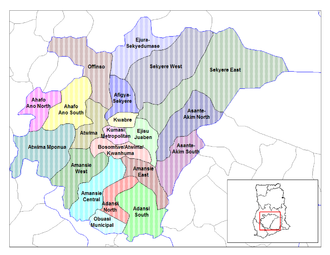Afigya-Sekyere District
| Afigya-Sekyere District | |
|---|---|

|
|
| country |
|
| region | Ashanti region |
| Capital | Agona |
| District shape | common |
| District Chief Executive | Ben Abankwa |
| surface | 770 km² |
| population | 117,653 (2004) |
| Population density | 153 Ew. / km² |
| ISO 3166-2 | GH-AH-AN |
The Afigya-Sekyere District is one of 21 districts in the Ashanti Region in Ghana . It has a size of 770 km² and approx. 117,653 inhabitants. The Afigya-Sekyere District borders in the south on the Kwabre District , in the southwest on the Atwima District , in the west on the Offinso District , in the north on the Ejura / Sekyedumase District , in the northeast and east on the Sekyere West District and over a small stretch in the East to the Sekyere East District . The capital Agona is about 10 kilometers north of Kumasi , the capital of the region.
economy
The economy in the district is characterized by a high proportion of employment in agriculture. Overall, around 64 percent of employees work in this sector, only around 4 percent of employees work in industry, and around 32 percent in the service sector.
The main crops used in agriculture are cassava , plantains , yam and corn. Cocoa, citrus fruits, coffee and palm oil are also grown as important export goods. A total of 6 percent of the farms work exclusively for the sale of goods, 21 percent are only active in the cultivation of their own needs. In 73 percent of the farms, the cultivated products are initially used for their own needs, but surpluses are also produced that are then sold.
Of all farms in the district, 67 work in mixed cultivation, only 7 percent cultivate monocultures, 4 percent work with the traditional method of alternating cultivation. 19 percent of the farms keep cattle in addition to cultivation and 3 percent of the farms belong to forestry. The average farm size per farmer is 3,687 acres.
There are 38 cattle farms in the district. Here the average number of cattle is 20 animals.
In the industrial sector there are forestry, metal and textile companies. The service sector is made up of both the private and public sectors. In the private sector, the size of the company is very small. Markets are held regularly in Boamang, Agona, Wiamoase and Bepoase.
traffic
The district has a road network with a total length of 180.2 km. Over 90 percent of these roads are sand tracks. The paved roads run through the district to connect Kumasi with Mampong . Another route runs through the district between Kumasi and Offinso. A 2 km long paved route runs from the district capital Agona to Wiamoase and between Ahenkro and Kyekyewere.
A general health insurance system is being tested in the district. 7000 people are recorded in the project. 3,000 of these make full contributions, 4,000 make a reduced contribution.
Representation of the people in the district
The district is led by the local parliament, the District Assembly (district assembly ) with 72 members. Of these 72 members, 48 are elected to the assembly in free elections, and a further 21 are appointed. There are three city councils, nine district administrators and 141 village committees in the district.
Between 2001 and 2002, the District Assembly invested a total of 4,293,250,000 Cedis (approx. € 429,000) in development projects. The money came from the World Bank , but mostly from the HIPC Fund and other donors. Between 2003 and 2004, the District Assembly invested 35,907,953,295 Cedis (€ 3,590,000) in construction projects. The District Assembly also supported women's groups with 25.5 million cedis in July 2002. The tourism sector was also supported with public funds totaling 20 million cedis.
population
In 1984 there were about 72,125 people in the district. As early as 2000, a census showed a population of 119,930 people; in 2004 the number had risen to 139,057. These figures correspond to an average growth rate of 3.1% per year. In the district, 35.6 percent of the population live in urban areas, 64.4 percent of the population live in rural areas. The district population is made up of 48.3 percent men and 51.7 percent women. The population between the ages of 0 and 14 represents about 36.4 percent of the total population, over 65 years are only 2.9 percent of the population. As a result, around 60.7 percent of the total population is in the economically productive age between 15 and 64 years.
Places with more than 5000 residents
|
|
|
Constituencies
There are two constituencies in the district for the Ghanaian parliamentary elections: One is the constituency Afigya-Sekyere West , for which Albert Kan-Dapaah stood for the New Patriotic Party (NPP). Kan-Dapaah is one of the leading politicians in Ghana and the incumbent interior minister in the cabinet of President John Agyekum Kufuor . Hennric David Yeboah has also entered parliament for the NPP for the second constituency of Afigya Sekyere East .
See also
Web links
- Statoids
- Ghanadistricts.com (English)